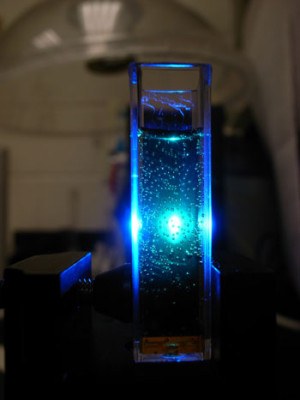Energy question of the week: Can sunlight be used to split water directly into oxygen and hydrogen?
Numerous groups of researchers around the world are pursuing this idea. Their objective is to use sunlight for the production of hydrogen as an energy source, by means of artificial photosynthesis. Based on the template provided by nature, the rays of the Sun need to be captured and have their energy transferred to a catalyst. On the surface of this catalyst, water can then be split into its constituent elements of oxygen and hydrogen.

Climate-neutral production of hydrogen as an energy source
Many materials such as titanium disilicide and metal complexes containing ruthenium or cobalt oxide are suitable as catalysts. However, these materials are either too expensive or not stable enough for large-scale industrial applications. A Franco-American team of researchers has managed to stabilise the cobalt oxide catalyst with carbon-free ligands to form polyoxometallates. The yield was, however, too low to serve as the basis for viable hydrogen production. Chemists at the University of California in Berkeley were able to use a molybdenum-oxo-complex with a higher yield of 8500 hydrogen molecules per catalyst molecule. However, these catalysts are not yet at a suitable stage for engineering applications, because their efficiency rating started to decline after three days.
There are still a few hurdles along the road to artificial photosynthesis, which will need to be cleared over the next few years, but the efforts could reap rich dividends. This is because hydrogen will have a future as an energy source only if it can be obtained inexpensively and in a climate-neutral manner. In principle, this will be primarily through hydrolysis, which involves using electricity from renewable sources to split the water molecules. A current, cheaper, and therefore more widespread, method is the process of obtaining hydrogen from natural gas, a fossil fuel. Efficient artificial photosynthesis would have the potential to replace both of these conventional methods.
Using a different approach, one that does not involve using technology to copy the process of photosynthesis, DLR researchers at the Institute of Technical Thermodynamics are splitting water into its constituent elements. In the EU projects HYDROSOL I and II, a system installed at the Spanish Plataforma Solar de Almería makes it possible to split water molecules using concentrated sunlight at temperatures of 800–1200 degrees Celsius. This approach has the potential to economically produce hydrogen with the help of solar energy in the foreseeable future.
The DLR Energy question of the week in 'The future of energy' Year of Science
The Federal Ministry of Education and Research (BMBF) has given the Year of Science 2010 the motto 'The future of energy'. For this reason the science journalist Jan Oliver Löfken will this year answer a question on the subject of energy in his blog each week. Do you have a question about how our energy supply might look in the future? Or do you want to know, for example, how a wave power plant works and how it can efficiently generate electricity? Then send us your question by email. Science journalist Jan Oliver Löfken will investigate the answers and publish them each week in this blog.
Tags:
